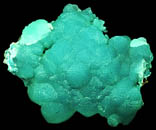|
|
| Formula: | ZnCo3 |  Click to see a larger image |
||
| Crystal: | Hexagonal | |||
| Hardness: | 4-4.5 | |||
| Spec. Gr.: | 4.4 | |||
| Streak: | White | |||
| Cleavage: | Rarely rhombohedral | |||
| Location: | Kelly, New Mexico |
| Since the Middle Ages, smithsonite was used in the production of brass, long before metallic zinc was discovered. It wasn't until the end of the 18th century that it was named after English Chemist J. Smithson who recognized it as a separate mineral. Pure smithsonite is colorless, often whitish and gray, but is colored yellow, orange, brown, pink, green, blue or black by admixture. Crystals are quite rare, but wonderful pink and yellow crystals up to five centimeters have come from Tsumeb, Namibia. Smithsonite is usually botryoidal or stalactitic. From Kelly, New Mexico, have come thousands of mamillary-shaped specimens, only a few of which have any resemblance of crystallized form, but, exhibit fresh bright hues of green, blue-green, green-blue to robin's egg blue. Associate minerals in the Kelly Mineare: calcite, aurichalcite, copper, azurite, dundasite, malachite, rosasite, silver, and wollastonite. |
|
Bibliography: Gibbs, Ronald B., The Magdalena District, Kelly, New Mexico. Mineralogical Record, V20, No. 1, 1989, pg. 13-24 |
|
University of California, Santa Barbara—Department of Earth Science Copyright © 2005 Regents of the University of California Send your comments to the Web Page Editor |